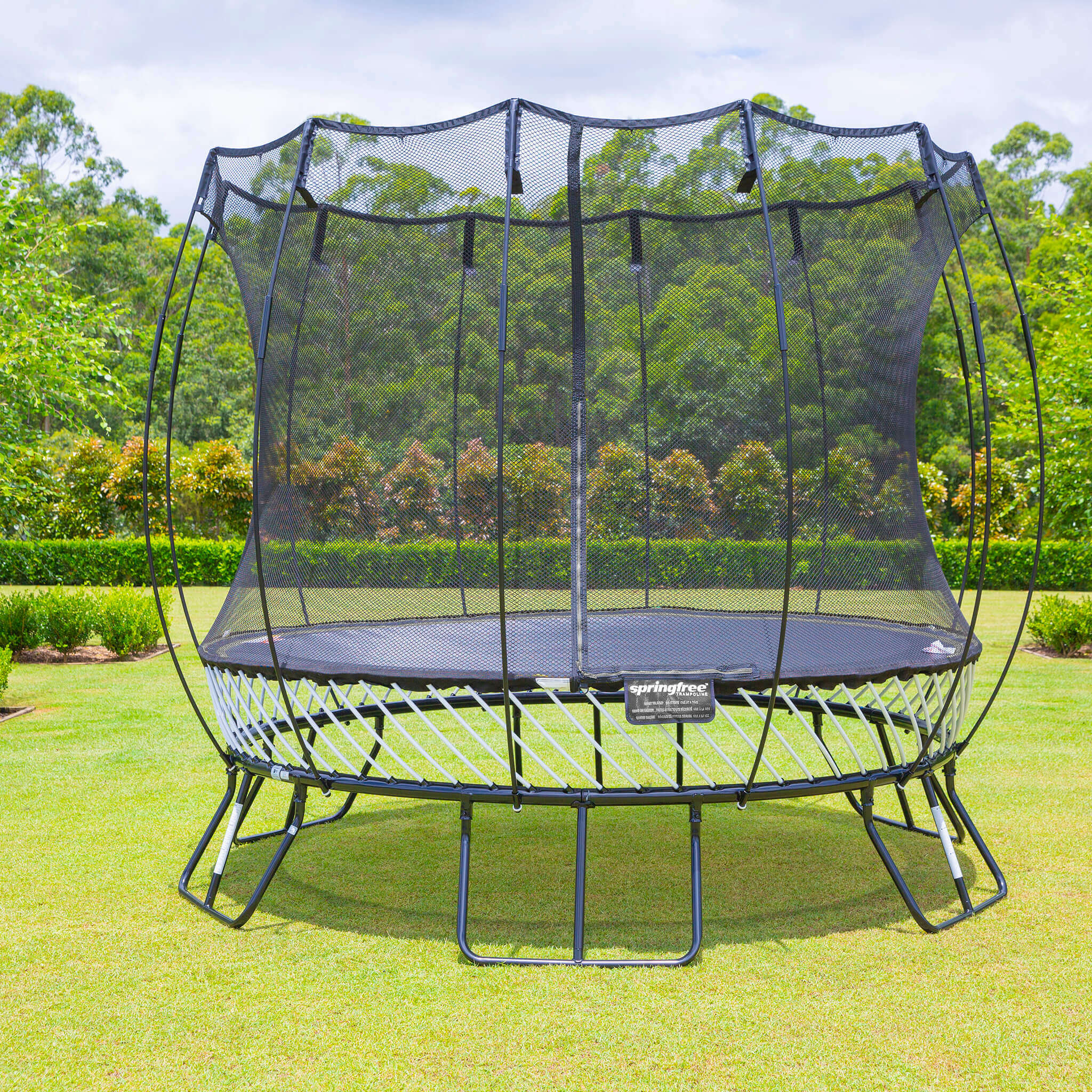Inground Trampolines vs. Above Ground Trampolines (Key Differences)
Understand the differences between inground trampolines and above ground trampolines with this guide. Learn the pros and cons of each, so you can make an informed choice!
min read

One of the major factors you need to consider before buying a trampoline is whether you want the trampoline to be installed in the ground or above the ground.
There are some major differences between an inground trampoline and an above ground trampoline, and it’s crucial that you understand these before purchasing. Deciding on the type of trampoline you want is potentially the most important part of purchasing the right trampoline.
Because choosing the wrong type of trampoline can lead to a plethora of problems: Wasted money, a less aesthetically pleasing backyard, and most impactfully, increased injury risk for your little jumpers.
That’s why we want to use our decades of experience as a springless trampoline innovator and manufacturer to go over the topic of inground vs. above ground trampolines to ensure you make the right choice for your family.
In this article, you will get a detailed look at how an inground trampoline differs from an above ground trampoline on factors like installation, cost, aesthetics, safety and more.
After reading this, you will feel readily informed and confident about which type of trampoline would be best for you and your family.
Dare we say, let’s jump into it (pun intended)!
What Is an Inground Trampoline?
Before getting to the difference between the two, let’s start by going over definitions of the two types of trampolines, starting with inground trampolines.
An inground trampoline, as you can probably guess by the name, is a trampoline that is installed into the ground rather than above the ground.
Example of an inground trampoline (via Trampolines Inground):

So, if an inground trampoline is installed in the ground, that means…
What Is an Above Ground Trampoline?
You guessed it! An above ground trampoline is the exact opposite of an inground trampoline: It sits above the ground rather than being installed into the ground.
Example of an above ground trampoline:

While the definitions of the two types of trampoline sound obvious and mundane, they require a much deeper look to see the real impact of choosing one over the other.
How you decide to install your trampoline affects many things, and we will use the ensuing sections to discuss all of these in detail.
7 Differences Between Inground and Above Ground Trampolines
They’re seven primary differences between inground trampolines and above ground trampolines. We’re going to start with the fundamental difference (installation) between the two before discussing the consequent components that come after installation:
-
Installation
As you now know, the basic difference between an inground and above ground trampoline revolves around installation: But how does this look in practicality?
Because inground trampolines are being installed in the ground, it requires a larger investment in money, time and space. An inground trampoline is a backyard commitment, much like a pool or fire pit would be.
Take a look at the image below for an inground trampoline installation (via Trampoline Holes):
Inground trampoline installation will usually require you to hire a professional because you have to:
-
Dig a hole
-
Ensure it is properly structured
-
Set up a proper drainage system
Because of the advanced installation, the process to install an inground trampoline will take longer than above ground trampolines.
For context, a Springfree Trampoline (designed to be installed above ground) takes 2-3 hours to fully assemble.
On the other hand, an inground trampoline can take anywhere from a few days to a few weeks to install, and because you usually need to hire a professional, can be contingent on how efficient the installers are.
Another prevailing factor of inground trampoline installation: It will increase the total cost of buying the trampoline because of the complexity of the installation. We will touch on the cost differences between the two in the next section.
Installation: Above ground > Inground
-
Cost
Because of the intricacy of the inground trampoline installation, it adds to the overall price of the trampoline.
The cost of an inground trampoline can range from $1,500-$5,000 or more, while an above ground trampoline can range from $100-$4,500 or more depending on the type and quality of the trampoline.
Cost: Above ground > Inground
-
Aesthetics
The first two differences went against the inground trampoline option, but this next difference is arguably in favor of installing a trampoline into the ground.
While beauty is subjective, a prevailing thought about above-ground trampolines is they can take away from the aesthetic of your backyard. This is especially the case with less expensive trampolines you might find at a retail store.
Alternatively, inground trampolines are looked at by many as the more visually attractive option because they take up less space and don’t stick out as much as above ground trampolines.
Example of an inground trampoline with enclosure (via JumpSport):
Aesthetics: Inground > Above ground
-
Safety
You ask any parent or supervisor, and the paramount concern among almost all of them regarding trampolines will be safety.
When it comes to typical inground vs. above ground trampolines, inground trampolines tend to be the safer option among the two. However, this comes with a caveat.
But first, let’s explain why inground trampolines are typically deemed to be the safer option. Since the trampoline is at ground level, inground trampolines eliminate the most frequent cause of injury among trampoline jumpers, which is falling injuries.
Even though almost all modern above ground trampolines have an enclosure net, there is still the chance that a jumper can fall through the net if it is not adequate enough to hold the impact of the jumper, which can result in a falling injury.
However, that is just one element to the trampoline safety conversation: Inground trampolines are still designed with metal springs and a metal frame. Taking a spill on one of these components can result in injury.
You can also still incur injuries from neglecting safe jumping rules—like too many people jumping on the trampoline at once, for instance. (Springfree recommends a “One Jumper at a Time Rule).
It can be argued that above ground trampolines containing safety features such as an advanced enclosure system, a hidden frame and composite rods instead of springs are just as, if not, safer than inground trampolines.
But these types of above ground trampolines (like our Springfree Trampolines) are on the pricier side. So, although the quality of the trampoline matters greatly in determining its safety, a typical inground trampoline is safer than a typical above ground trampoline due to the elimination of falling injuries.
Safety: Inground > Above ground
-
Durability
Durability, or how long the trampoline will last, is another vital concern among buyers looking to purchase a trampoline.
Just like safety, the better option among inground and above ground trampolines can depend on the quality of the trampoline. You can argue that high-quality above ground trampolines are just as durable as inground trampolines.
However, once you get to the less expensive above ground models, you run into more durability concerns than inground models.
Since inground trampolines are installed in the ground, they can withstand strong wind conditions much better than traditional above ground trampolines. You don’t have to worry about your inground trampoline blowing away under heavy winds.
Additionally, inground trampolines will not succumb to sun-related damage or rust that above ground trampolines can experience.
Durability: Inground > Above ground
-
Flexibility
The next difference between the types of trampolines involves their ability to be easily moved if needed.
Say you’re wanting to do a complete backyard makeover and want to move the resident trampoline to a different part of your yard.
If you have an above ground trampoline, this process would be rather seamless. You can use shifting wheels or have multiple people pick up and transfer the trampoline to its new desired location.
But if your trampoline is installed in the ground, then you’re not going to be able to easily move it. That would basically require you to start a brand-new installation process (not ideal for anyone).
It’s also a pain if you’re moving to a different house: Since the trampoline is in the ground, you would need to plan for professional assistance and landscaping to take the trampoline out of the ground and restore the yard back to its previous form.
An inground trampoline is a permanent structure in your backyard. So, if you needed to move it in the future, it’s going to cost you.
Flexibility: Above ground > Inground
-
Accessibility
The seventh difference we will touch on in this article is accessibility, or how easy it is to get in and out of the trampoline.
There doesn’t need to be much explanation here: Since inground trampolines are at ground level, they will be easier to access than above ground trampolines.
With above ground trampolines, you may need to use a ladder and will have to zip and unzip the trampoline net to enter/leave the trampoline.
Accessibility: Inground > Above ground
Which Type of Trampoline Is Right for You?
You’ve seen all of the major differences between an inground trampoline and an above ground trampoline.
You now can make an informed decision on which type of trampoline makes the most sense for your situation.
We can tell you from our experience in the trampoline industry that above ground trampolines tend to be more popular because they are more affordable and easier to install.
But that doesn’t mean everybody should buy an above ground trampoline. As you saw in the differences between the two, there are certain things—like aesthetics, prevention of falling injuries, durability and accessibility—that inground trampolines win out on.
Our advice? Set your goals, align them with your budget and go find the best trampoline for you.
That’s a pretty broad statement, though. At Springfree Trampoline, we make it our mission to objectively inform you about what you need to make the best purchase for your family. With that being said, we have some content for you if you want a sure-fire way to set your goals.
The type of trampoline you want will go a long way toward determining which trampoline is right for you. However, this is just the first determining factor you need to assess.
There are additional aspects to consider before you choose the trampoline that will provide you with plenty of joyful moments and the least amount of issues.
Read through our blog on what to consider when buying a trampoline, use it to set your goals and make sure you get your ideal trampoline the first time around.
